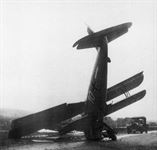Фотографии
-
Quartet of early-model Messerschmitt Bf 109s illustrating variations on two basic “incident” attitudes in the Bruchlandung or crash-landing book, the groundloop and the wheels-up conditions. All four accidents occurred in September 1939, by which time the majority of Bf 109 B-2s had been downgraded to the Jadgfliegerschulen for fighter-pilot training. The Messerschmitt narrow-track main undercarriage rarely forgave a Bumslandung or heavy landing, and once on the ground the main gear still had the option to protest over sharp movements by collapsing outwards or even inwards. Note the curving groundloop trail in picture 5.
Самолёты на фотографии: Messerschmitt Bf.109 / Bf.109B / Bf.109C / Bf.109D - Германия - 1935
-
Luftwaffe wits coined the ironical term Fliegerdenkmal or “air memorial” for this most embarrassing of pilot predicaments. In this case snow may have clogged the “Stuka” (dive-bomber) main-wheel streamlined “spats”; the place in Germany is not quoted, but the date was February 18, 1940. The fuselage unit code-letters “SI+GK” suggest that “Rote Gustave” (individual letter “Red-G”) was on the strength of the Second Stoffel of the First Stukageschwader (2./St.G.I).
Самолёты на фотографии: Junkers Ju.87B - Германия - 1938
-
This picture was taken at an un-named Jagdfliegerschule or Fighter Pilots School only six days after the start of World War Two. This is the least damaged of several Czechoslovakian-built Avia B-534 fighter-trainers which were involved when a conversion Bf 109 collided with one of these four-gun (7 92-mm) biplanes. The pilot’s canopy identifies this as a B-534 of the IVth Series.
Самолёты на фотографии: Avia B-534 - Чехословакия - 1933
-
The uncertain perils of icy slush have helped to slither this obsolescent fighter, an Arado Ar 68 (individual “10”) of an unidentified Jagdgeschwader's Second Gruppe, through a boundary fence in the execution of a well-defined Ringelpietz or groundloop. The date was January 16, 1939.
Самолёты на фотографии: Arado Ar.68 - Германия - 1934
-
Регистрационный номер: D-IFDC Summer madness? An unexplained Kopfstand (literally “head stand”) on June 30, 1939, by a Luftwaffe Gotha Go 145 intermediate trainer. Perhaps the clue is the Andrehkurbel or inertia starter handle still in the Argus engine cowling.
Самолёты на фотографии: Gotha Go.145 - Германия - 1934
Статьи
- -
- Bristol Bombay /Press Debut/
- Fairey Fulmar /Preservation Profile/ (18)
- Farnborough Spotlight
- Personal album
- Skywriters
- ??? - Ricklef's Spad
- B.Cousens - A pigeon and a prayer
- B.Gunston - New York - London in under two hours
- B.Gunston - U.S. Navy prop-hangers
- B.Martin - Britain's civil aircraft register
- M.Fricke - Swiss tri-motor
- P.Birtles - The Comet racers
- P.Moss - British Airways (1)
- R.Baxter - On meeting an old friend




